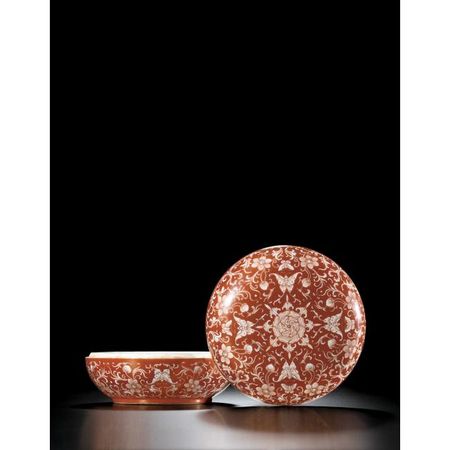Fine Iron-Red Coral Ground Floral Circular Box and Cover, Mark and Period of Yongzheng
Fine Iron-Red Coral Ground Floral Circular Box and Cover, Mark and Period of Yongzheng
the slightly domed cover with a flat top delicately painted in the reserve on the white body with a mallow floret in the center radiating eight trefoils towards four butterflies with outstretched wings, each confronting a smaller butterfly, bordered around the sides with lotus flowers and buds on a detached acanthus leaf scroll, the sides of the box similarly decorated with butterflies and lotus echoing the design on the cover, all reservered against a bright iron-red coral ground, the interior glazed white, the base of the box marked with a six character underglaze-blue reign mark within double circles. 15.1 cm., 6 in. Estimate 4,000,000—6,000,000 HKD
PROVENANCE: H.R.N. Norton no. 179.
Sotheby's London, 5th November 1963, lot 202.
LITERATURE AND REFERENCES: R.P. Marchant, 'Some Interesting Pieces of Marked Ch'ing Porcelain', Bulletin of the Oriental Ceramic Society of Hong Kong, no. 3, 1977-78, pls 24-26.
NOTE: This meticulous pattern with its lace-like effect, which plays on the sharp contrast between the iron-red enamel and the white porcelain, was one of the many imaginative inventions of the Yongzheng period. It was only in this reign that all enamels were scrutinized as to their unique properties and thus, possibilities. The iron-red enamel, which adheres in a thin, opaque layer, allows for razor-sharp lines, which cannot be achieved with other enamels, which are thicker and glassier. This effect was here fully utilized, giving this 'negative' reverse design a delicacy rarely achieved with 'positive' painting on a white ground.
Only one companion piece appears to be known, a box of the same form, design, colour scheme and reign mark from the Sir Percival David Collection in the British Museum, London, included in the International Exhibition of Chinese Art, Royal Academy of Arts, London, 1935-6, cat. no. 1748 (fig. 1).
In the Qianlong period this design was turned into a simplified floral scroll pattern without butterflies, and used on the outside of bowls. As such, the pattern continued throughout the 19th century. A Qianlong bowl, also from the Sir Percival David Collection in the British Museum, is illustrated in Oriental Ceramics. The World's Great Collections, vol.6, Tokyo, 1982, col. pl. 94; another from the collection of E. and J. Baerwald was included in the Ausstellung Chinesischer Kunst, Berlin, 1929, cat. no. 1034.
This harmonious rounded box shape was devised in the Yongzheng reign when it was repeatedly used, both with monochrome glazes and fencai (famille rose) enamels. Compare a monochrome coral-red box of this shape, also of Yongzheng mark and period, in the Baur Collection, Geneva, illustrated in John Ayers, Chinese Ceramics in the Baur Collection, Geneva, 1999, vol.2, pl. 334; or another, from the Bradley and Enid and Brodie Lodge collections, exhibited in Monochrome Porcelain of the Ming and Manchu Dynasties, Oriental Ceramic Society, London, 1948, cat. no. 48 and sold in our London rooms, 11th July 1978, lot 206.
Equally as rare as the present box and equally growing in popularity from the Qianlong period onwards is another red reserve design of the Yongzheng period, in form of white bamboo stems on red-enamelled bowls; for a comparison of Yongzheng and Qianlong examples of that design see Marchant, loc.cit., pls 27-30.
Sotheby's. Eight Treasures from a European Collection. 08 Apr 09. Hong Kong. www.sothebys.com photo courtesy Sotheby's

/https%3A%2F%2Fprofilepics.canalblog.com%2Fprofilepics%2F1%2F0%2F100183.jpg)
/https%3A%2F%2Fstorage.canalblog.com%2F03%2F02%2F119589%2F96711876_o.jpg)
/https%3A%2F%2Fstorage.canalblog.com%2F11%2F31%2F119589%2F94773502_o.jpg)
/https%3A%2F%2Fstorage.canalblog.com%2F20%2F83%2F119589%2F94772815_o.jpg)
/https%3A%2F%2Fstorage.canalblog.com%2F26%2F72%2F119589%2F75604929_o.jpg)
/https%3A%2F%2Fstorage.canalblog.com%2F59%2F60%2F119589%2F26458628_o.jpg)






/image%2F1371349%2F20240425%2Fob_0b83fb_440387817-1657715464998466-20094023921.jpg)
/image%2F1371349%2F20240425%2Fob_d8802e_440367117-1657711318332214-11984536568.jpg)
/https%3A%2F%2Fassets.over-blog.com%2Ft%2Fcedistic%2Fcamera.png)
/image%2F1371349%2F20240425%2Fob_e64568_440367995-1657703268333019-41468471616.jpg)